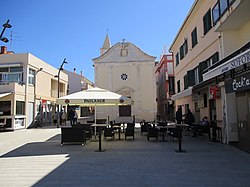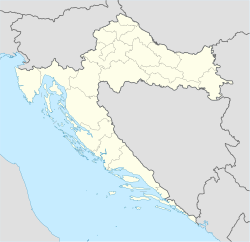Novalja
Novalja | |
|---|---|
 Novalja city center | |
| Coordinates:44°33′N14°53′E/ 44.550°N 14.883°E | |
| Country | |
| County | |
| Island | Pag |
| Government | |
| • Mayor | Ivan Dabo Đono (HDZ) |
| Area | |
| •Town | 95.7 km2(36.9 sq mi) |
| • Urban | 42.5 km2(16.4 sq mi) |
| Population (2021)[2] | |
| •Town | 3,680 |
| • Density | 38/km2(100/sq mi) |
| •Urban | 2,415 |
| • Urban density | 57/km2(150/sq mi) |
| Time zone | UTC+1(CET) |
| • Summer (DST) | UTC+2(CEST) |
| Website | novalja |
Novalja(pronounced[nǒʋaʎa]) is atownin the north of the island ofPagin theCroatianpart ofAdriatic Sea.In recent times, Novalja has become famous because of theZrće Beach.
History[edit]
The earliest settlers on the island were anIllyrian tribethat came to the region in theBronze Age;traces of their settlement can still be seen around Pag. In the 1st century BC, theRomanstook possession, and have left numerous archeological and cultural artifacts.[citation needed]
Novalja is the successor of a Roman city calledCissa,considered by many scholars to be the seat of an ancient Christianbishopricof that name. Others prefer to identify the see with an island city of the same name inIstria,close to present-dayRovinj.A bishop of Cissa named Vindemius took part in some year between 571 and 577 in aschismaticsynod in Grado called byPatriarch Elias of Aquileia.Arrested by theExarch of Ravennahe was forced to abjure his views on thecontroversy of the Three Chapters,but once free fromByzantine Empirecontrol reaffirmed his position and took part in another schismatic synod in 590. A bishop of Cissa called Ursinus took part in a synod at Rome in 680 and signed the acts. Soon after, Cissa ceased to exist, perhaps because of an earthquake.[3][4][5]No longer a residential bishopric, Cissa is today listed by theCatholic Churchas atitular see.[6]
TheCroatsarrived in the 7th century along with the great migration and settled in the area. The island was for some time under the rule of theCroatian kingdom.Yet the island was always fought over, and in the 11th and 12th centuries was divided between the communities ofRaband ofZadar.[citation needed]Novalja was given to the community and diocese of Rab by CroatianKing Petar Krešimir IV.From the 12th to 14th centuries, Novalja, along with otherDalmatiantowns and islands, it was fiercely contested between theRepublic of Veniceand theCroatian-Hungarian rulers.[citation needed]For four centuries from the start of the 15th century it was held by Venice, until Venice lost its independence.AustriaandFrancethen fought over the Dalmatian area with victory going to the Austrians.
The island passed from Austria to theKingdom of YugoslaviaafterWorld War I,and then to theIndependent State of Croatia(1941–1945). After the Second World War it returned to Yugoslavia and, when this broke up, it became part of the new state ofCroatia.Unusually, the island is divided between two counties, with Novalja andStara Novaljabeing part of the northernLika-Senj County.
Population[edit]
| population | 1024 | 1187 | 1610 | 1876 | 2151 | 2641 | 2641 | 3362 | 3799 | 3779 | 3533 | 3384 | 3069 | 3175 | 3335 | 3663 | 3680 |
| 1857 | 1869 | 1880 | 1890 | 1900 | 1910 | 1921 | 1931 | 1948 | 1953 | 1961 | 1971 | 1981 | 1991 | 2001 | 2011 | 2021 |
Villages[edit]
Gallery[edit]
References[edit]
- ^Register of spatial units of the State Geodetic Administration of the Republic of Croatia.WikidataQ119585703.
- ^"Population by Age and Sex, by Settlements"(xlsx).Census of Population, Households and Dwellings in 2021.Zagreb:Croatian Bureau of Statistics.2022.
- ^Francesco Lanzoni,Le diocesi d'Italia dalle origini al principio del secolo VII (an. 604),vol. II, Faenza 1927, p. 850
- ^Francesco Babudri,Il vescovato di Cissa in Istria,in Atti e memorie della società istriana di archeologia e storia patria, vol. XXXI (1919), pp. 33-57
- ^R. van Doren, v.Cissa,inDictionnaire d'Histoire et de Géographie ecclésiastiques,vol. XII, Parigi 1953, col. 851
- ^Annuario Pontificio 2013(Libreria Editrice Vaticana 2013ISBN978-88-209-9070-1), p. 870













